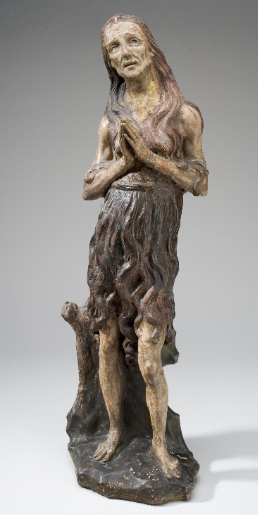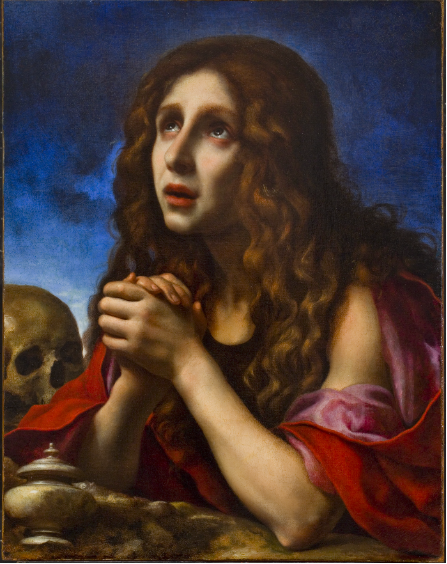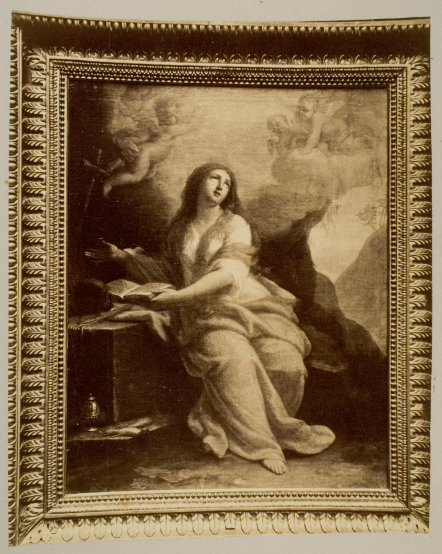The Davis Museum is closed for Wellesley College’s winter break. Please join us at our spring opening celebration on February 5, 2026, at 4 pm.
Penitent

Unidentified Italian artist, in the manner of Andrea del Verrocchio, Mary Magdalene, Late 15th or early 16th century, ca. 1500, Polychromed terracotta, 64.8 cm x 21.6 cm x 17.1 cm, 1967.15.
The Bible does not address Mary Magdalene’s life after Christ’s resurrection, but the ninth century text Vita eremitica beatae Mariae Magdalenae and the thirteenth century compilation Golden Legend both elaborated upon her biography. Her presumed special need for penance reflected the idea that she had to repent of her sins as a prostitute. As mentioned above, she was confused with Mary of Egypt, a figure from the Golden Legend who had prostituted herself before her conversion to Christianity. This Italian sculpture and its history illustrates the ongoing confusion between these two Marys. In a letter written at the time of its acquisition by the museum, acting museum director Franklin W. Robinson referred to the sculpture as a “wonderful North Italian Maria Egyptiaca.” Her hair, previously symbolizing her sensual life, became her clothes of repentance. This work was probably inspired by the penitent Mary Magdalene made of wood and on a life-sized scale by Donatello around 1455. This may be a sketch for a larger work or a medium for private devotion, a sign of the importance of the saint and of her assimilation to the effort of penitence.
***

Carlo Dolci, The Penitent Magdalene, Ca. 1670, Oil on canvas, 65.1 x 51.1 cm, 1958.19.
After the Council of Trent in the sixteenth century, artists’ presentation of the saint in penance was also a reflection on death but with the hope of resurrection, symbolized by prayer. In Carlo Dolci's portrait of Mary Magdalene, her lush hair and exposed shoulder signal past sensuality and reasons for penance. The perfume jar again identifies the saint and her devotion to Christ whom she anointed. The skull indicates her reflection on the vanity of the world. This painting was probably intended for private devotion. The saint's attitude, with her hands joined in prayer, her eyes reddened with tears, and her mouth ajar, would have served as an example to inspire the viewer’s own repentance.
***

Unknown artist, Mary Magdalene by Giuseppe B. Chiari, Late 19th century, Albumen print, 35.6 cm x 27.9 cm, 1989.71.17.2.
The painting reproduced in this Albumen print was made by the Baroque painter Giuseppe Bartolomeo Chiari. After its invention in 1839, one of the first functions assigned to photography was to copy painted and sculpted works, thus replacing engraving and allowing the diffusion of certain iconographies. Mary Magdalene carries her familiar attributes, along with others of penance: the perfume pot, the skull, leather straps for self-flagellation, a crucifix and the Bible. Chiari represented the moment just before one of the saint's seven daily ecstasies. The angels are spreading the clouds to carry her to heaven. The evocation of Mary Magdalene in penance impacted the lives of certain women who were considered sinners and called to repentance. In 1257, the convent Santa Maria Maddalena Penitente was founded in Florence to host former prostitutes. The last convent of the Magdalene (or “Magdalene Laundry”), which took in, often against their will, women rejected by society, closed its doors in Ireland in 1996.